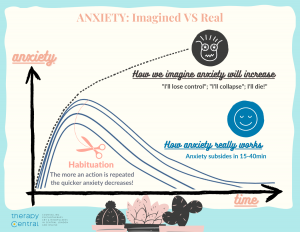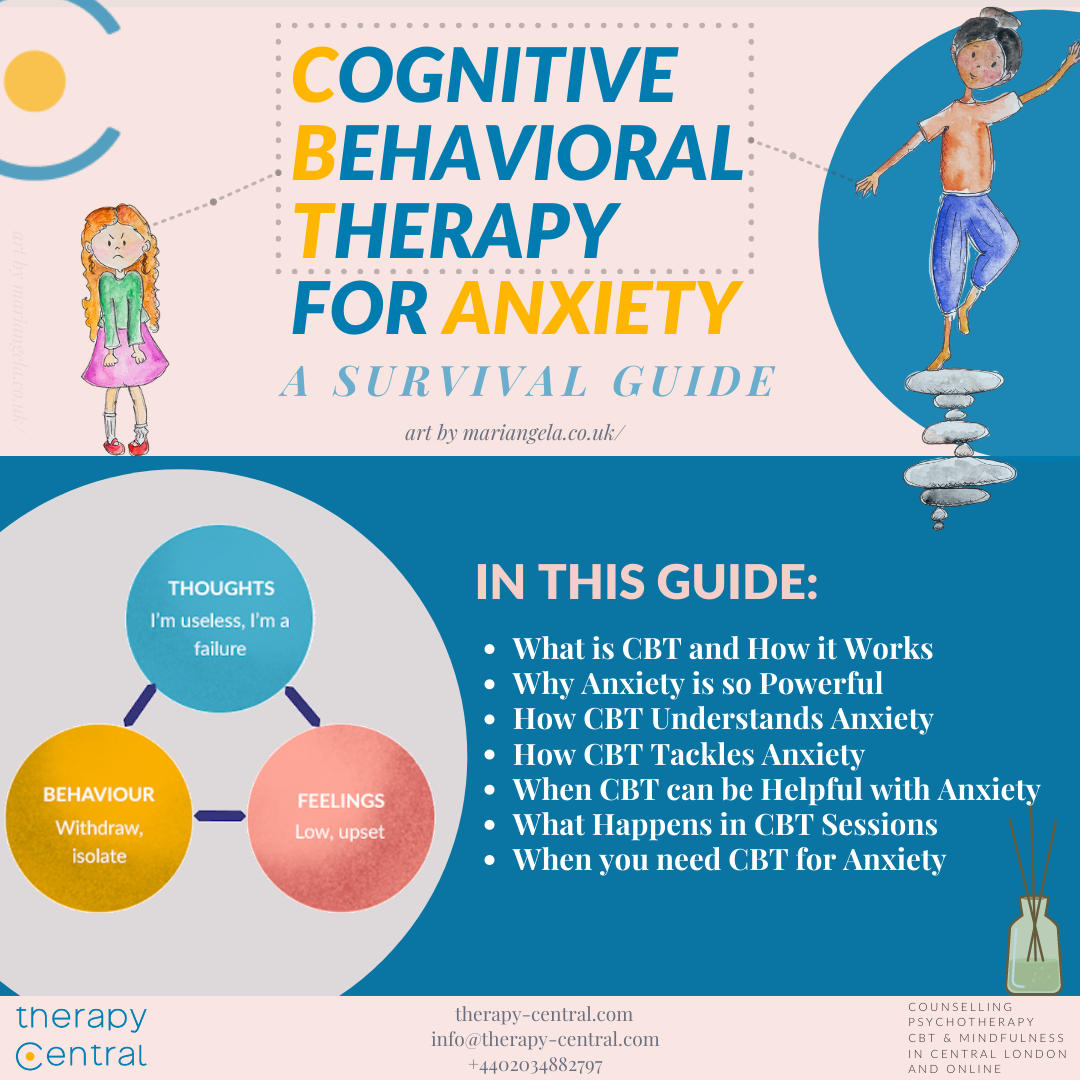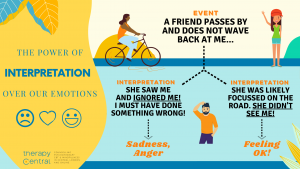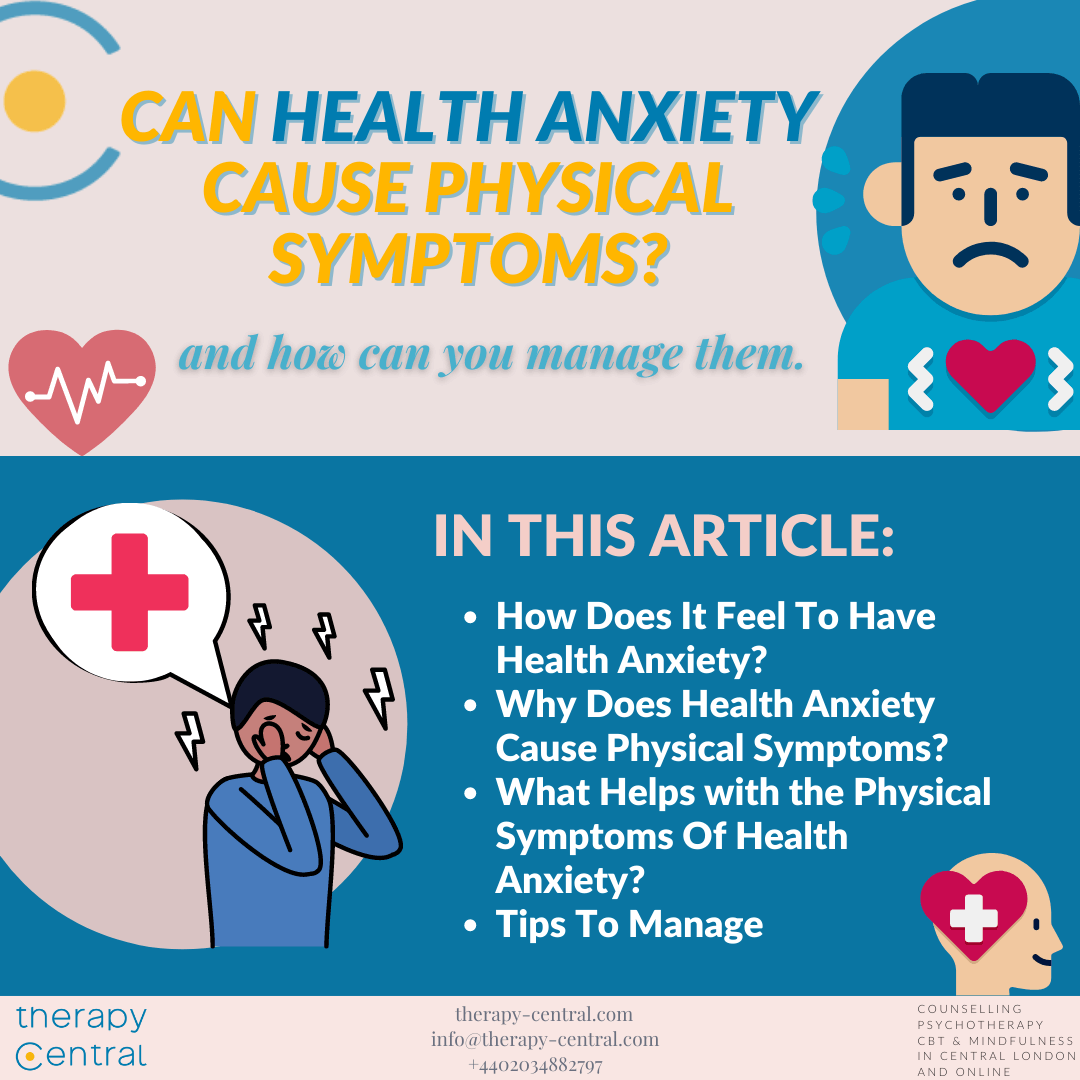Anxiety is one of the most common mental and emotional health issues globally, and one we’ve been trying to alleviate for a long time. Fortunately, we have Cognitive Behavioural Therapy (CBT in short). CBT is the most evidence-based (proven by science) approach to help people deal with their anxiety challenges and allow them to live the life they want.
What is CBT?
CBT is one of the most commonly used approaches to tackle anxiety. Psychologists, therapists, and counsellors with appropriate training use it regularly in private practice and the NHS to help people deal with many mental health issues, including anxiety.
CBT is so popular because, from its inception in the ’60s by American Psychologist Aaron Beck, it accumulated an incredible amount of peer-reviewed research proving its effectiveness. It also became a prevalent treatment option for anxiety issues and is highly recommended by NICE (National Institute for Health and Care Excellence). Most people with problems such as Panic Disorder, Generalised Anxiety Disorder (GAD), Health Anxiety (Hypochondria) and Social Anxiety Disorder (SAD) can significantly benefit from CBT [1].
How does CBT work?
We have produced an extensive article about how CBT works; however, in brief, CBT operates by focusing on how we think and how this, in turn, affects our feelings and behaviours.
CBT uses two main components:
1) Cognitive therapy
This component of CBT helps examine and address troublesome (often negative) thoughts and how they affect anxiety. For example, things like “My presentation will be a disaster!”; “If I get on the train something terrible will happen!”; “This bump on my head must be a brain tumour!”.
2) Behavioural therapy
This part of CBT focuses on our behaviours i.e. what we do. It pays attention to and addresses the impact of how people react to anxiety-provoking situations (for example: calling in sick to avoid giving a presentation at work; googling ‘bump on the back of the head’ to cope with the fear it may be a tumour, and so on)
What is CBT’s Main Idea?
The Cognitive Principle is perhaps one of the most influential and liberating ideas that CBT tries to convey. It states that It’s our thoughts and not external events that make us feel anxious/. In other words, it’s not the situation per se that determines how we feel, but how we interpret it that leads to anxiety (and at times low-mood, anger, etc.). Of course, some situations are inherently stressful and anxiety-provoking, however, the way we interpret them moderates the impact they have upon us. For example, following the cognitive principle, it’s not giving a work presentation itself that causes our anxiety. Instead, it’s our negative thoughts about how it will go that makes us feel like we’d like to call in sick to avoid it.
If we think about it, our interpretation of events happening in our lives is the critical component of how we will feel about them. The role of appraisal, another work for interpretation, is the reason not everybody will feel anxious at the idea of giving a presentation: some will feel excited, others indifferent, others perhaps frustrated, and some others anxious. It seems evident that with so much variability, it cannot possibly be the presentation itself (the event) that causes us to feel anxious. Our anxiety is generated by our interpretations about such an event, e.g., “It will be a disaster”; “I’ll make a fool of myself”; “Others will laugh at me”; “I will lose my job”, and so on.
Share this Image On Your Site
Why choose CBT to help you with an Anxiety issue?
Besides being the most recommended approach, based upon research [2], CBT has several advantages to help people with anxiety.
It is often focused more on the here and now, and sometimes it does not need to look deeply at the past history to help bring balance back into your life. A greater focus on the present makes CBT a faster way to get some positive results when dealing with anxiety than other approaches. Research shows improvement in anxiety symptoms between 8-16 sessions: this is perhaps the most significant advantage of CBT in treating anxiety and one of the reasons for its popularity [3].
Also, once completed a course of CBT therapy for anxiety, you’ll be equipped with a variety of tools to help you face the inevitable challenges that life will throw at you. When this happens, you will be able to use the techniques you have learned and be more prepared to face difficulties successfully.
How Do Psychology and CBT Understand Anxiety?
Anxiety is a Precious Survival Tool
Anxiety is not a ‘bad’ emotion. On the contrary, it’s what has allowed us, humans, to stay alive until now for the many years we have been on our planet. Anxiety will enable us to escape a dangerous situation. It will save our lives and those of our loved ones. It also prevents us from ending up in difficult circumstances. We are equipped with anxiety because simply put, it is evolutionally fundamental to our survival.
Anxiety is linked to the famous ‘Fight or Flight’ response. This is activated when threat is perceived: heart rate and pressure will increase, pushing blood to our hands and feet, moving it away from the centre, so we can get ready to fight or run (for our life!).
However, although we no longer live in an environment where we are in danger much of the time, for some of us, anxiety or the Fight or Flight response gets activated in response to arguably not dangerous situations. For example, receiving an angry email from our boss, or when we are afraid people won’t like us in a social circumstance. How can we make sense of this?
Anxiety as an Over-Sensitive Smoke Detector
Modern psychology and CBT understand anxiety as functioning like a kitchen smoke alarm that can’t tell the difference between steam produced by water boiling and smoke coming from a dangerous fire. If we had such a defective, over-sensitive smoke alarm fitted in our kitchen, it would provoke many undesirable events disrupting our lives. Imagine preparing a nice meal requiring us to boil some water, and all of a sudden, the steam produced triggers off the alarm. We would be immediately startled by the sharp sound that would grab our attention entirely. The need to make it stop would become our top priority. Such a process would certainly not allow us to enjoy an otherwise pleasant and relaxed moment.
Like this over-sensitive smoke alarm, when we suffer from an anxiety issue, it will go off for something really threatening, which we should be afraid of (e.g., being threatened by somebody, or facing a break-in). However, it will also go off when the trigger is arguably inconsequential and innocuous. For example, negative images (e.g., us collapsing on the floor) emerging while waiting for the tube to go to work, having a difficult discussion with a colleague at work, etc. As we could not ignore the smoke alarm going off in the example above, we can certainly not ignore our anxiety when it emerges in these instances. Our attention will be invariably placed on doing everything we can to reduce it. This is because anxiety causes an unpleasant cascade of interconnected physical (e.g. increase in heart rate, shortness of breath) and psychological events (worrying thoughts, anxiety, stress) resulting from some trigger (i.e., stressor) happening in our environment.
How Anxiety Claims our Complete Attention
It’s tough to ignore an anxiety reaction and continue focussing on what we are doing when it emerges. From a biological perspective, we may feel it in our stomach. We might notice our sweaty palms, feel our heart and breath racing, our chest compressed, and a general sense of tension may creep up in our bodies.
In our minds, worries, doubts, fears and scary images may arise, further fuelled by noticing our bodily reaction, which, in turn, will be made worse.
Unfortunately, as with the over-sensitive smoke alarm, our need to calm our anxiety will take all of our attention, energy and enjoyment away from our every-day activities just as the false alarm in the kitchen will not allow us to enjoy our meal preparation.
Avoidance: Anxiety’s Best Friend
With all this survival activation going on, and the irresistible (and understandable) need to make it stop, one coping mechanism is deployed: avoidance. To deal with the stressors, which make us feel worried, afraid and anxious, we tend to avoid, escape, take distance, go in the opposite direction. This reaction is normal: who would deliberately want to face something scary and very-anxiety provoking when we could avoid it? Avoidance is also desirable because it makes our anxiety diminish, if not disappear entirely. If we are anxious about that work presentation, calling in sick will immediately have a calming effect on our difficult emotions. We will feel relieved that we won’t have to expose ourselves to what we imagined as a highly embarrassing or humiliating experience. But there’s a big catch. Avoidance may be helpful in the short-term (or else we wouldn’t use it!), but in the long-term avoiding won’t let the anxiety go away.
On the contrary, we will feel more and more anxious. Our anxiety will grow as avoidance increases our level of sensitisation to anxiety-provoking situations. In other words, the more we avoid, the more we keep using a defective smoke-alarm!
We need to learn to deal with our survival, fight or flight reaction, in our modern world, in a more useful way, and CBT can help us do so.
CBT Vicious Cycles: How Anxiety is Maintained
You are at a social gathering and have just started talking to a group of new people. This is a common threatening situation for you, that triggers fears like ‘others won’t like me’, or ‘I am boring’, and ‘I will be rejected’. You notice your heart starts pounding, your hands sweating. Your attention is no longer on the conversation. Instead, it has moved inwards. You are focussed on your body response and on the mistakes you are afraid you might be making. You then focus on the others, trying to notice whether they’ve spotted your anxiety and are judging you: you’re scanning for threats. At this point, the desire to escape and get out of the situation starts mounting up. As it becomes unbearable, you end up making an excuse and leave to go back home.
As soon as you leave, you feel relief, your anxiety is subsiding, and you’re gradually becoming calm again.
Although escaping provides a sense of relief, it is likely to make you want to further avoid future similar social situations. It will be the best way to get further relief. However, this is not a long term solution. You are inadvertently trading short-term anxiety relief via avoidance/escape for long term worsening of your anxiety. Social withdrawal, loneliness and low self-confidence and self-esteem are also likely to set in. As your anxiety calms down, self-judgements could emerge, such as “I am not even able to meet a few new people, I am just not good enough’.
This rapid and escalating succession of events is an example of what happens when people feel anxious in social situations. CBT calls it Vicious Cycles. Vicious Cycles not only describe what happens when anxiety escalates, but crucially why anxiety is maintained, and made worse, over time.
Anxiety is maintained because of how we choose to deal with it. In our example, we couldn’t resist the urge to leave and avoid. Unfortunately, this course of action means that physical sensations are likely to present themselves again, together with feeling even more unsure of yourself at the next similar social situation. Avoiding and escaping means our fears (e.g., ‘Others won’t like me’) have gone untested. We will experience more worry about future situations. Vicious cycles may also lead to self-fulfilling prophecies. Others may indeed be less likely to invite us to events the more we reject or cancel invitations. They may end up like us less.
Invariably, whenever there’s an anxiety issue, a vicious cycle is likely to be at play. One of CBT’s most essential aspects is helping uncover and understand how they work and find ways to break them and replace them with virtuous cycles. CBT uses various techniques to do this. It focuses on our response to anxiety (our behaviours) and what generates anxiety in the first place (our thoughts and interpretations).
How does CBT tackle Anxiety?
1) Fighting avoidance: Learning to Move towards what we fear
This is where the ‘Behavioural’ part of CBT shines. And here’s how. We discussed that we naturally respond with avoidance to situations that make us feel anxious. Although this is helpful in the short term, in the long run, we’ll be over-sensitised. Thus, avoidance will increase the chances we will continue to experience anxiety, and at even higher levels, in similar situations in the future. It turns out that our innate anxiety-avoidance attitude may work against us! Desensitisation is the worst enemy of avoidance and can help break the cycle of anxiety.
What if, instead of avoiding, we could stay in an anxious situation without escaping it? Perhaps you may think your anxiety will increase to the point you’ll lose control, make a fool of yourself, or worse collapse and even die! This is far from the truth.
What we know will actually happen is that we’ll notice our anxiety dropping after a few minutes, and eventually subside after between 15-40 minutes.
The more the situation is repeated, the more our anxiety curve will consistently decrease when exposed to the same circumstances.
Think about the first time as children we go to school. For many, this would have been very anxiety-provoking: leaving our homes and parents’ comfort and safety and stepping into a strange new world. Somehow though the more we continued to expose ourselves to this new environment, day after day, the more anxiety dropped. For most, it fell to the point we could find a way to not only forget about our initial fears but even enjoy going to school and meeting our new friends and classmates.

Share this Image On Your Site
What happened when we first started going to school is a process known as habituation, which is one of the principles used by CBT therapist working with anxiety. Going towards what we fear lets our bodies and mind become accustomed to it. It reaches the point that fear and anxiety don’t emerge as often and become weaker when they do.
CBT helps us understand that if we continue to avoid certain anxiety-provoking situations (e.g., taking the tube, meeting new people, giving a presentation, etc.) we won’t change our reaction to them. Body and mind won’t have a chance to learn that there’s no real threat or that even in the presence of a perceived threat we can, and /we will,/ survive.
In a nutshell, CBT helps us desensitise by learning how to safely move /towards/our object of fear, essentially reversing avoidance.
However, CBT does not just throw us in feared situations unprepared. It helps us expose to anxiety-provoking situations gradually. For example, CBT helps us slowly increase the number of social events we attend and progressively starting to say ‘no’ more often. At the same time, it works on our thoughts and interpretations about such feared situations (e.g., “Others will think I am stupid”). After all, it is both how we think (addressed by the Cognitive Therapy part of CBT) and what we do (the Behavioural one) that inform and maintain our anxiety.
2) Challenging our negative thoughts, beliefs and interpretations
CBT, deploying Cognitive Therapy, works on thoughts just as powerfully as it works on behaviours. As we’ve mentioned, the reason for feeling anxious about a situation is often found in the thoughts, images and beliefs we attach to these situations.
The most common beliefs (and related triggers), fuelling anxiety are along the following lines:
“I’ll have a heart attack” trigger: noticing my heart racing.
“I won’t be able to cope” trigger: thinking about a potential divorce
“I’ll be humiliated” trigger: having to give a work presentation.
“I’ll be rejected” trigger: being at a social gathering
“I’ll lose control/faint/cry” trigger: thinking about an oral exam
“I’ll be overwhelmed by anxiety itself” trigger: thinking about a job interview
“Something bad will happen” trigger: waiting for your train to arrive
In CBT, we can address these and many other negative beliefs by talking about them and externalising them with the therapist.
You’ll notice that the greatest majority of these thoughts, beliefs and interpretations are usually left unchallenged. These negative thoughts crop up as a consequence of a trigger (i.e., learning that we have to give a work presentation). We seem to accept them as absolute truths. It’s only normal to feel anxious if we truly and fully believe that, for example, upon giving the presentation “I’ll be humiliated” and “others will laugh at me”. Nobody would want to experience either of those things.
CBT posits that It is these thoughts, and our blind belief in them, that directly allow our anxiety to emerge. Nonetheless, these thoughts are just one way we can interpret a situation, one which we seem to be at the mercy of. But what if there was a way to critically look at such thoughts rather than accept them as absolute truths?
Looking at and critically evaluating and challenging thoughts and interpretations is another potent tool in the CBT arsenal.
CBT practitioners use various methods to do this, from using journals and diaries, to help individuals recognise well known ‘cognitive distortions’.
Thoughts are put on the stand, like in court. Evidence is brought forward which support as well as contradict the thought examined. The result of this process is usually a more balanced and less threatening and anxiety-provoking thought which, based on evidence, is also sufficiently ‘believable’. This thought challenging technique helps up move from:
a) ‘the presentation will be a disaster, and I’ll be humiliated’ (Anxiety level 9/10) to something like
b) ‘I only believe the presentation will go bad because of my anxiety. I have spoken in public in the past, and it didn’t go that bad and, as I am competent about what I’ll be talking, the presentation will likely go ok’. (Anxiety level 4/10)
Moving from the first thought to the second can lower our anxiety level sensibly about the work presentation, and crucially helps us make the behavioural choice not to avoid and attend the presentation. In this way, we have a chance to finally start breaking our vicious cycle and make our way through beating anxiety.
3) Setting in a Virtuous Cycle
Cognitive and behavioural techniques work hand in hand in CBT to fight anxiety and transform vicious cycles into virtuous ones.
Accepting that a new, less threatening thought might be true, starts lowering our anxiety towards something we fear, but this is just one piece of the puzzle. It is only when we change our behaviour, going towards what we fear that we can see that, after all, it was ‘ok’. We can finally start dismantling our negative thoughts and beliefs, which kept us anxious.
We need to experience the feared situation to achieve long-lasting change. Using the example above, we gave ourselves the chance to experience that the terrible things we were predicting didn’t happen by attending the presentation. Perhaps giving that work presentation may not have been enjoyable. Still, we/did /survive it, and did not feel humiliated or smeared by others.
Based upon hard evidence, this positive feedback will increase our willingness to do the same action again and again and again, until we can do it with confidence, and sometimes even with enjoyment.
Situations where CBT can Help with Anxiety
The same mechanism for change in CBT highlighted above in the case of a work presentation is valid for virtually all situations in which we feel anxious, for example:
- Finding it difficult to date or meet someone now
- Feeling nervous about asking our partner to contribute more to house chores
- Feeling stuck at work and not being able to ask for a raise we deserve
- Feeling afraid of speaking up for fear that others will think we’re stupid
- Not being able to use the lift or the tube fearing something terrible
These are just a few examples, but whenever you notice a vicious cycle of negative thoughts and avoidance, CBT is likely to be able to help. Discover more about CBT Therapy
What happens in the CBT sessions for anxiety?
In a CBT session, your therapist will first ask you to identify problems linking them to behaviours, thoughts and feelings. Examining thoughts and behaviour patterns will make it easy to focus on what keeps your anxiety going. Specifically, you’ll uncover your thinking styles and behaviours that might allow anxiety to continue affecting your life negatively.
Focussing on the thinking and behavioural patterns is the golden path to making changes and managing anxiety, if not lift it entirely.
As with most therapeutic approaches, a session of CBT usually lasts 50 minutes and often includes homework in between sessions, for example, writing down notes like thoughts and behaviour in a diary or journal. Homework reveals another distinctive feature of CBT: it is highly collaborative. Working with your CBT therapist will often feel like working in a team, where you’re the expert on the matter (how you feel, think and act, and what you want to achieve). Your therapist is the expert on the method (CBT). Together you’ll join forces to achieve a common goal: make crucial changes in your thinking and behavioural patterns and thus feel less anxious and more in control of your life and emotions.
It’s never too late for CBT for Anxiety
One significant advantage of CBT is that people can use it for different problems of different severities. It can be helpful to tackle initial mild anxiety symptoms, as well as more severe and or enduring presentations.
CBT can prove useful whether you have just started to notice some initial signs. You may have spotted your heart beating faster when thinking about work. Perhaps when in bed trying to sleep, your mind makes long lists of items awaiting you on the following day. However, CBT can also be helpful when anxiety has started to harm our ability to function in our daily lives. In these cases, anxiety may not allow you to use public transport or leave home altogether, making it difficult to go to work or meet friends. Or perhaps you have withdrawn from most of your social activities due to anxiety and worries about how others may perceive you. In all these instances, CBT can be a powerful ally.
Who can provide CBT for Anxiety?
Although CBT is very widely practised, it does not mean everyone can provide it. Only practitioners with specific, certified training should help people struggling with mental and emotional health problems using CBT, (or any other approach really). Competent CBT therapists, such as the ones working at Therapy Central, go through several years of training that allow them to register with one or more regulatory, professional bodies, such as the HCPC (Health and Care Professions Council) and BABCP. When looking for a therapist to help you with any issues you might have, it’s always useful to check their credentials and ask about their training and certifications.
As anxiety is one of the most common mental health issues, professional training in CBT always involves working in clinical settings where practitioners are exposed to practising with a variety of the anxiety-based problems: OCD (Obsessive-Compulsive Disorder); PTSD (Post-Traumatic Stress Disorder); Social Anxiety; Health Anxiety; GAD (Generalised Anxiety Disorder), as well as Panic Disorder and more.
Do I need CBT therapy for Anxiety?
We wrote this article to help you get a more profound sense of CBT therapy for anxiety, especially as it’s currently so widely used in private and public sectors. The hope is that it managed to help you understand a bit more about anxiety and how CBT looks at and works with it.
There is a lot more that we could cover. Still, this article needs to end at some point, and there will be more, smaller ones in the future that will focus on specific aspects of CBT and anxiety.
In the meantime, if you feel that you or someone you know and care about are struggling with anxiety, it’s essential not to leave it unchecked. Perhaps you have noticed negative thoughts cropping up and avoidance creeping in, or you’ve spotted the physical signals of anxiety discussed earlier on. Maybe you’re at a place where you are noticing the first signs, or you’ve been dealing with anxiety for some time, and it already affected your ability to enjoy life as you would like. Whatever the circumstances, CBT could help start tackling anxiety and make the crucial changes to bring back balance and fulfilment in your life. Nobody should face anxiety alone.
Get a FREE 15 min consultation to talk about your anxiety with a CBT therapist. Contact Us today.











